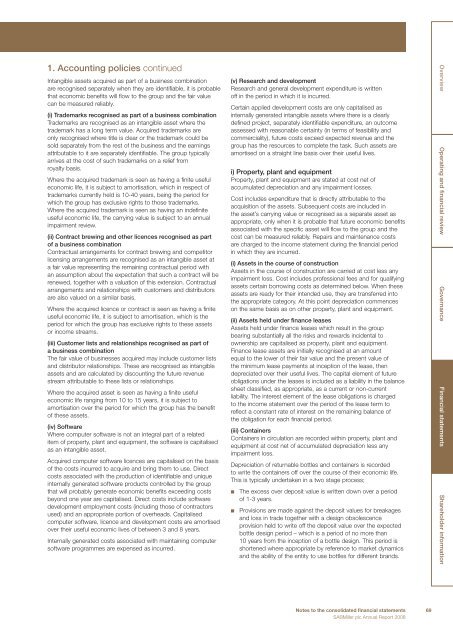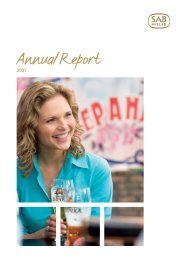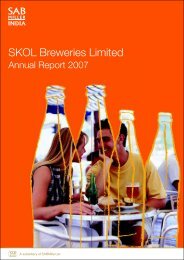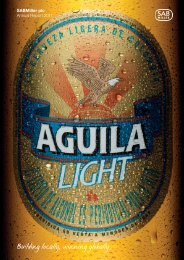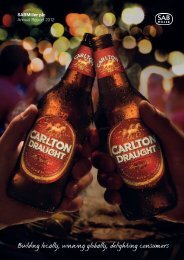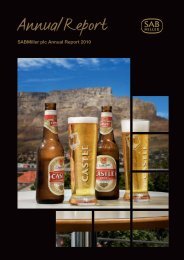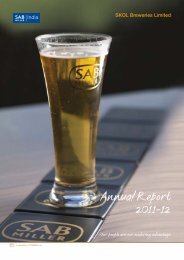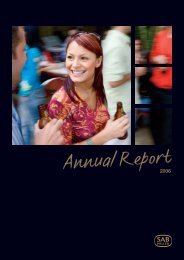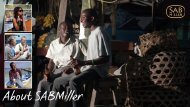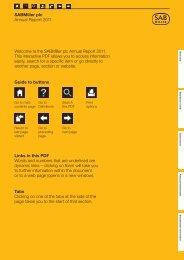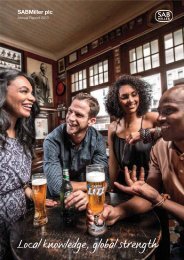Annual Report - SABMiller India
Annual Report - SABMiller India
Annual Report - SABMiller India
- No tags were found...
Create successful ePaper yourself
Turn your PDF publications into a flip-book with our unique Google optimized e-Paper software.
1. Accounting policies continuedIntangible assets acquired as part of a business combinationare recognised separately when they are identifiable, it is probablethat economic benefits will flow to the group and the fair valuecan be measured reliably.(i) Trademarks recognised as part of a business combinationTrademarks are recognised as an intangible asset where thetrademark has a long term value. Acquired trademarks areonly recognised where title is clear or the trademark could besold separately from the rest of the business and the earningsattributable to it are separately identifiable. The group typicallyarrives at the cost of such trademarks on a relief fromroyalty basis.Where the acquired trademark is seen as having a finite usefuleconomic life, it is subject to amortisation, which in respect oftrademarks currently held is 10-40 years, being the period forwhich the group has exclusive rights to those trademarks.Where the acquired trademark is seen as having an indefiniteuseful economic life, the carrying value is subject to an annualimpairment review.(ii) Contract brewing and other licences recognised as partof a business combinationContractual arrangements for contract brewing and competitorlicensing arrangements are recognised as an intangible asset ata fair value representing the remaining contractual period withan assumption about the expectation that such a contract will berenewed, together with a valuation of this extension. Contractualarrangements and relationships with customers and distributorsare also valued on a similar basis.Where the acquired licence or contract is seen as having a finiteuseful economic life, it is subject to amortisation, which is theperiod for which the group has exclusive rights to these assetsor income streams.(iii) Customer lists and relationships recognised as part ofa business combinationThe fair value of businesses acquired may include customer listsand distributor relationships. These are recognised as intangibleassets and are calculated by discounting the future revenuestream attributable to these lists or relationships.Where the acquired asset is seen as having a finite usefuleconomic life ranging from 10 to 15 years, it is subject toamortisation over the period for which the group has the benefitof these assets.(iv) SoftwareWhere computer software is not an integral part of a relateditem of property, plant and equipment, the software is capitalisedas an intangible asset.Acquired computer software licences are capitalised on the basisof the costs incurred to acquire and bring them to use. Directcosts associated with the production of identifiable and uniqueinternally generated software products controlled by the groupthat will probably generate economic benefits exceeding costsbeyond one year are capitalised. Direct costs include softwaredevelopment employment costs (including those of contractorsused) and an appropriate portion of overheads. Capitalisedcomputer software, licence and development costs are amortisedover their useful economic lives of between 3 and 8 years.Internally generated costs associated with maintaining computersoftware programmes are expensed as incurred.(v) Research and developmentResearch and general development expenditure is writtenoff in the period in which it is incurred.Certain applied development costs are only capitalised asinternally generated intangible assets where there is a clearlydefined project, separately identifiable expenditure, an outcomeassessed with reasonable certainty (in terms of feasibility andcommerciality), future costs exceed expected revenue and thegroup has the resources to complete the task. Such assets areamortised on a straight line basis over their useful lives.i) Property, plant and equipmentProperty, plant and equipment are stated at cost net ofaccumulated depreciation and any impairment losses.Cost includes expenditure that is directly attributable to theacquisition of the assets. Subsequent costs are included inthe asset’s carrying value or recognised as a separate asset asappropriate, only when it is probable that future economic benefitsassociated with the specific asset will flow to the group and thecost can be measured reliably. Repairs and maintenance costsare charged to the income statement during the financial periodin which they are incurred.(i) Assets in the course of constructionAssets in the course of construction are carried at cost less anyimpairment loss. Cost includes professional fees and for qualifyingassets certain borrowing costs as determined below. When theseassets are ready for their intended use, they are transferred intothe appropriate category. At this point depreciation commenceson the same basis as on other property, plant and equipment.(ii) Assets held under finance leasesAssets held under finance leases which result in the groupbearing substantially all the risks and rewards incidental toownership are capitalised as property, plant and equipment.Finance lease assets are initially recognised at an amountequal to the lower of their fair value and the present value ofthe minimum lease payments at inception of the lease, thendepreciated over their useful lives. The capital element of futureobligations under the leases is included as a liability in the balancesheet classified, as appropriate, as a current or non-currentliability. The interest element of the lease obligations is chargedto the income statement over the period of the lease term toreflect a constant rate of interest on the remaining balance ofthe obligation for each financial period.(iii) ContainersContainers in circulation are recorded within property, plant andequipment at cost net of accumulated depreciation less anyimpairment loss.Depreciation of returnable bottles and containers is recordedto write the containers off over the course of their economic life.This is typically undertaken in a two stage process;■■The excess over deposit value is written down over a periodof 1-3 years.Provisions are made against the deposit values for breakagesand loss in trade together with a design obsolescenceprovision held to write off the deposit value over the expectedbottle design period – which is a period of no more than10 years from the inception of a bottle design. This period isshortened where appropriate by reference to market dynamicsand the ability of the entity to use bottles for different brands.Overview Operating and financial review Governance Financial statements Shareholder informationNotes to the consolidated financial statements 69<strong>SABMiller</strong> plc <strong>Annual</strong> <strong>Report</strong> 2008


